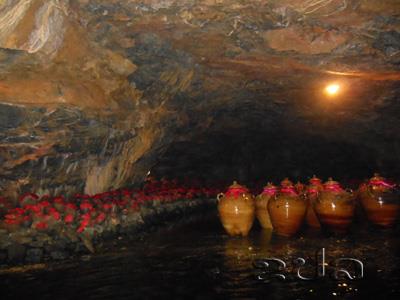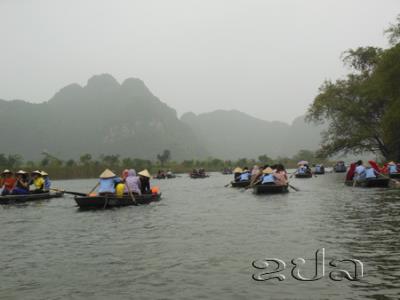KPL
We spent three hours traveling in a mini-bus to the Trang An scenic landscape complex in Ninh Binh province, just around 100 km from central Hanoi. When in Hanoi, visiting this World Heritage site is easy and worth doing for visitors.
Trang An scenic landscape complex is located in Ninh Binh province. It was recognized by UNESCO as a mixed natural and cultural property in June, 2014.

Local tourists visit Tran Temple
Soukthavy – Manythone
(KPL) We spent three hours traveling in a mini-bus to the Trang An scenic landscape complex in Ninh Binh province, just around 100 km from central Hanoi. When in Hanoi, visiting this World Heritage site is easy and worth doing for visitors.
Trang An scenic landscape complex is located in Ninh Binh province. It was recognized by UNESCO as a mixed natural and cultural property in June, 2014.
Over 10,000 local and foreign visitors visit the Trang An every day. The daily number of visitors reaches 12,000 in the weekend. Here around 2,000 boats are prepared for arrival visitors.
The turbulent movement of earth crust hundreds of million years ago endowed Ninh Binh with a unique nature of labyrinth of cave, mountain, lake, and historical relics.
 Very long time ago the cave was used for keeping wine jars
Very long time ago the cave was used for keeping wine jars
Covering an area of nearly 2,000 ha, the complex is divided into five areas: special reservation area (ancient capital of Hoa Lu), core area, cave area, tourism service areas, and spiritual tourism area of Bai Binh pagoda mountain.

Boats taking visitors to the caves
Floating in a small boat in green and fresh lake, we have amazed by the shade of mountain range reflected in the fresh lake surface, various kinds of wild flowers bloom and dark rock cliff, some goats searching for feed flicker under branch of trees…
The 50 submerged caves act as a gateway leading to other valleys in total span of 20km long. Typical of the caves are Toi (dark) cave which is 315m long and 60m high, Ba giot (Three drops), Seo, Lo, Dot, Dai Linh, Ao trai, and Nau ruou (wine making). They have different features that make Trang An an attractive system of caves.
Assoc. Prof. Nguyen Khac Su from the Institute of Archaeology said that Trang An used to house the first capital of the Vietnamese feudal and independent state, Hoa Lu, more than 1,000 years ago. Its rugged landscape provided a favourable location for a secure and easily defended citadel.
Even though over 10 centuries have passed and Hoa Lu is no longer the capital, relics have been left behind, including the temples dedicated to Dinh Tien Hoang (968-979), Le Dai Hanh (980-1005) and several one-pillar pagodas from different dynasties. All have helped to build the legend that exists around this ancient culture.
"In Vietnam up to now, few limestone tools have been found, except here at Trang An, while in Malaysia a few similar tools have been discovered. I guess they are from the Hoa Binh culture (12,000-10,000 BC). They indicate that several archaeological caves in Southeast Asia share certain similar features," he says.
Soukthavy Thephavong and Manythone Keolangsy both are journalists of the KPL News of the Lao News Agency.
KPL